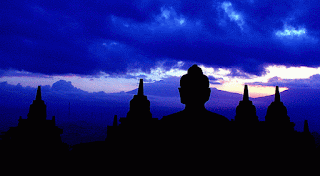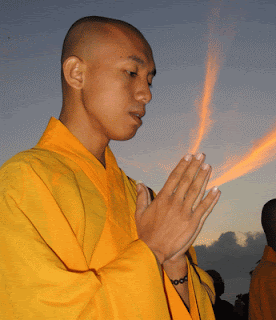The countryside
around Yogyakarta has accommodated a lot of remains of the ancient Buddhist and
Hindu temples such as the world’s largest Buddhist temple of Borobudur an 7th
century by the rulers of the Syailendra dynasty, built by King Samaraturangga.
Hailed as the most complete ensemble of Buddhist relief in the world. As one of
the seventh wonders of the world magnificent Buddhist sanctuary that is also
known as one of the world wonders and Majestic is Borobudur Temple. Located
about 42 kilometers Northwest of Yogyakarta near Mungkid in the Magelang
Regency.
The walls of it’s
seven terraces rising up to the Great Stupa carved with bas reliefs of grey
andest stone illustrate the life of Buddhist. This massive stupa is the largest
Buddhist monument in the world. As the biggest Buddhist Temple Borobudur and
one of the wonders monuments in the world, was built around the year 78 – 850
AD. It was left to ruin as the dynasty fell apart, and only recognized as a
global treasure by Stamford Raffles in 1814. It has subsequently been restored
to it’s former glory it’s 10 exquisitely carved levels reaching 42 meters in
height.
Believed to have
been built in the 7th century A.D. Borobudur rises majestically on
it’s hillock overlooking the green plains and distant hills of what is known as
the “Garden of Java”. Scholars believe the monument to have been a mandala a
structure built to assist in meditation. It’s seven terraces rise toward the
great stupa which crowns the monument. Base reliefs depicting the life of
Buddha adorn the black andesite stone balustrades for a length of about six
kilometers.
Borobudur is a 9th-century MahayanaBuddhistTemple in Magelang, Central Java, Indonesia. The
monument consists of six square platforms topped by three circular platforms,
and is decorated with 2,672 relief panels and 504 Buddha statues.A
main dome, located at the center of the top platform, is surrounded by 72
Buddha statues seated inside a perforated stupa. Built in the 9th century during the
reign of the Sailendra Dynasty, the temple's design in Gupta
architecture reflects India's influence on the region. It also depicts the gupta style from India
and shows influence of Buddhism as well as Hinduism. The monument is both a shrine to the Lord Buddha and
a place for Buddhist pilgrimage. The journey for pilgrims begins at the base of the monument
and follows a path around the monument and ascends to the top through three
levels symbolic of Buddhist cosmology: Kāmadhātu
(the world of desire), Rupadhatu (the world of forms) and Arupadhatu
(the world of formlessness). The monument guides pilgrims through an extensive
system of stairways and corridors with 1,460 narrative relief panels on the
walls and the balustrades.
Evidence suggest Borobudur was
constructed in the 9th century and abandoned following the 14th century decline
of Hindu kingdoms in Java, and the Javanese
conversion to Islam. Worldwide knowledge of its existence was sparked in 1814
by Sir Thomas Stamford Raffles, then the British ruler of Java, who
was advised of its location by native Indonesians. Borobudur has since been
preserved through several restorations. The largest restoration project was
undertaken between 1975 and 1982 by the Indonesian government and UNESCO, following which the monument was
listed as a UNESCO World Heritage Site. Borobudur is still used for
pilgrimage; once a year Buddhists in Indonesia celebrate Vesak at the monument, and Borobudur is
Indonesia's single most visited tourist attraction.
In Indonesian, ancient temples are referred to as candi; thus locals refer to "Borobudur
Temple" as Candi Borobudur. The term candi also loosely
describes ancient structures, for example gates and baths. The origins of the
name Borobudur however are unclear, although the original names of most
ancient Indonesian temples are no longer known. The name Borobudur was first
written in Sir Thomas Raffles' book on Javan history. Raffles wrote
about a monument called borobudur, but there are no older documents
suggesting the same name. The only old Javanese
manuscript that hints at the monument as a holy Buddhist sanctuary is Nagarakretagama,
written by Mpu Prapanca in 1365.
The name Bore-Budur, and thus BoroBudur,
is thought to have been written by Raffles in English grammar to mean the
nearby village of Bore; most candi are named after a nearby village. If
it followed Javanese language, the monument should have been named
'BudurBoro'. Raffles also suggested that 'Budur' might correspond to the modern
Javanese word Buda ("ancient") "ancient Boro"
However, another archaeologist suggest the second component of the name (Budur)
comes from Javanese term bhudhara (mountain). The construction and
inauguration of a sacred Buddhist building—possibly a reference to
Borobudur—was mentioned in two inscriptions, both discovered in Kedu, Temanggung Regency. The Karangtengah inscription, dated 824, mentioned a sacred
building named Jinalaya (the realm of those who have conquered worldly
desire and reached enlightenment), inaugurated by Pramodhawardhani,
daughter of Samaratungga. The Tri Tepusan inscription, dated 842, is mentioned in the sima,
the (tax-free) lands awarded by Çrī Kahulunnan (Pramodhawardhani) to ensure the
funding and maintenance of a Kamūlān called Bhūmisambhāra. Kamūlān
is from the word mula which means 'the place of origin', a sacred
building to honor the ancestors, probably those of the Sailendras.
Casparis suggested that Bhūmi Sambhāra Bhudhāra, which in Sanskrit means
"The mountain of combined virtues of the ten stages of Boddhisattvahood",
was the original name of Borobudur.
Since Borobudur and
Prambanan are acclaimed as one of the world’s wonders monument, it’s been the
evidence of the great achievement of our ancestor who have the spirit of strong
leatdership and character. Commitment, hardworking, persistence, never give up
spirit, could do mentality, responsibility, cooperation, etc.
The Elephant’s Borobudur
Gajah-gajah dan
serangkaian kereta dipersiapkan setiap hari untuk melayani perjalanan wisata di
sekitar Candi Borobudur. The Elephants making travel through villages
surrounding Borobudur Temple and having directly experience of Javanese’s
tradition life. While traveling on the elephant we could enjoy the beauty of
nature, the wide greeny farming area with the greatness of Borobudur at the
left side background and Menorech Hill at the right side. During 2,5 hours on
the elephant wewe will have an exciting and unforgetable experience.Part of the
Borobudur complex are two Hindu temples, Pawon temple and the Buddha Sayamuni
in Mendut Temple, are also conveniently on route from Yogyakarta to Borobudur.


















